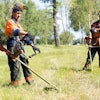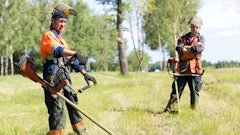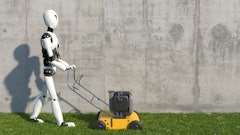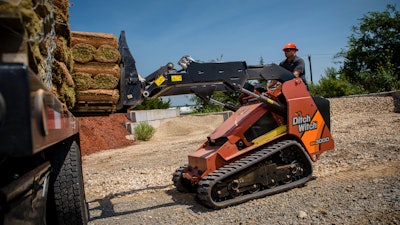
If you feel like you’re unable to hire workers to get the job done, you’re not alone. The 2021 Green Industry Benchmark Report found that attracting and retaining employees is still the most frequently cited issue in the green industry, with more than 70% of landscapers reporting difficulties in finding employees in their industry.
While the industry comes together to find solutions to attract and retain employees, an easy and immediate step you can take to compensate for a lack of workers is to make sure you are maximizing use of your equipment. By following our three machine tips, you can be sure your machines are helping you do more with less.
Tip 1: Easy Operation Means Simple Productivity
With a smaller crew, each job is an all-hands-on-deck endeavor, where every crew member needs to be able to help with any task. This means that each employee needs to be knowledgeable about and confident in operating every piece of equipment. Whether it’s a crew member who has been on the site one day, or someone who has been in the industry for 20 years, everyone should be able to hop on a machine and feel confident knowing they can operate it.
A variety of factors play into making a machine easy to operate. The first is knowing that crew members can access convenient training tools, whether online, in a classroom or on the jobsite. This can help ensure that your crew knows how to safely operate equipment while optimizing every equipment feature. It also can help get new employees trained and to the jobsite quickly.
The second factor is making sure that your equipment has features that help operators safely, quickly and efficiently complete any job. An example of this is a stand-on skid steer. The hop-on/hop-off ability of a stand-on machine is very beneficial for smaller crews, because it’s easy for crewmembers to transition between operating the machine and helping with manual labor. The open platform also provides a 360-degree view of the jobsite, so operators can confidently work in tight spaces, in both forward and reverse.
When every minute counts, especially when a small crew is involved, making sure equipment is easy to learn and operate can help increase productivity on any jobsite.
 With smaller crews and growing demand, many landscapers are taking on two or three different jobs in a day, so machines with more power will keep crews efficient, leading to higher profits.Ditch Witch
With smaller crews and growing demand, many landscapers are taking on two or three different jobs in a day, so machines with more power will keep crews efficient, leading to higher profits.Ditch Witch
Tip 2: Power Equals Efficiency
From a ski boat to a car to landscaping equipment (and everything in between), there’s a reason why people want machines that are powerful. More power means higher efficiency, and in our busy world, higher efficiency saves time and money. This is no different on a landscaping jobsite.
Powerful equipment is key when there is less manpower on the jobsite. Machines with more power can fill the gaps by lifting loads that would otherwise require three or four workers. Machines that can pick up and transport more weight reduces the time spent loading or unloading materials from trucks, ultimately helping crews move more quickly through a project.
With smaller crews and growing demand, many landscapers are taking on two or three different jobs in a day, so machines with more power will keep crews efficient, leading to higher profits.
For example, Jeremy Folsom, owner of Folsom Tree Service in Benton, Ark., says that his efficient, safety-focused process harnesses the power of two critical pieces of equipment: a 19-inch-capacity tree chipper and a full-size stand-on skid steer.
“We generally bring only the stand-on skid steer to the jobsite because it has the power to complete all the tasks we need done, and its ability to use attachments just doubles down on that,” Folsom says. “With both the large chipper and the power of the stand-on skid steer, I can lay a 3,000-pound treetop on the ground with my crane, pick it up with the stand-on skid steer and feed it into the chipper at five minutes per pick. The stand-on skid steer helps me give my customers the best, most efficient service possible.”
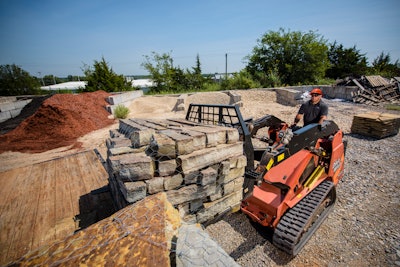 Operators can now have one machine for a variety of landscaping tasks. For example, an operator can take one machine on a job, load, dig or move material with a backhoe attachment, swap out to a trenching attachment to dig an irrigation line and then attach a bucket to remove dirt and then restore the ground with a box rake attachment.Ditch Witch
Operators can now have one machine for a variety of landscaping tasks. For example, an operator can take one machine on a job, load, dig or move material with a backhoe attachment, swap out to a trenching attachment to dig an irrigation line and then attach a bucket to remove dirt and then restore the ground with a box rake attachment.Ditch Witch
Tip 3: Versatility is a Crew’s Best Friend
Versatile machines are growing in popularity with landscapers. A versatile machine offers landscapers the ability to take on multiple different jobs with one machine by utilizing its different attachments. Plus, having just one machine on-site reduces transportation headaches and keeps jobsites from being congested.
Operators can now have one machine for a variety of landscaping tasks. For example, an operator can take one machine on a job, load, dig or move material with a backhoe attachment, swap out to a trenching attachment to dig an irrigation line and then attach a bucket to remove dirt and then restore the ground with a box rake attachment.
In one instance, Darrel Anderson, owner and CEO of D2Scapes, a landscape company based in Hot Springs, Ark., credits the versatility of stand-on skid steers for allowing his crew to take on two separate residential landscaping projects at one time.
“Being able to easily switch attachments is key to helping us to accomplish a variety of jobs with just the one machine,” Anderson says. “Since many of our jobs are in residential areas that already have multiple vehicles taking up jobsite space, the ability to bring just one machine to a jobsite is a huge plus. In the future, I definitely plan to continue looking into new attachments that can help my crew take on new jobs. I believe that will be the future of how we work.”
Demand for landscape work is expected to stay strong despite the unknown longevity of the labor shortage. This means landscape professionals will need equipment that is easy to learn, simple and safe to operate and innately efficient, while delivering the power and versatility needed to get multiple jobs done, even with a small crew.

